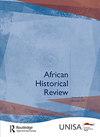The House of Tshatshu: Power, Politics and Chiefs North-West of the Great Kei River, c1818–2018, by Anne K. Mager and Phiko J. Velelo
IF 0.1
Q3 HISTORY
引用次数: 0
Abstract
This book is a detailed account of the peaks and troughs of an independent chiefdom over a lifespan linking colonial southern Africa and post-apartheid South Africa. It identifies the chiefdom of amaTshatshu as a sub-house of the kingdom of abaThembu, which, in the 1820s, left the increasingly turbulent Mbashe area (later referred to as “Thembuland proper”) and crossed over Tsomo River into “Bushmanland,” a territory between Stormberg and Amathole Mountains. By the 1830s “Bushmanland” had become turbulent too, due to the passage of more Thembu groups into the territory, the eastward and southward colonial advances by the British and the Boers, and the clashes between the newcomers and the “Khoesan” groups inhabiting the territory. From the 1830s to the 1880s, the amaTshatshu were embroiled in the bloody conflicts of the eastern frontier, and were severely weakened by land dispossessions, the cattle-killing movement between 1856 and 1857, and colonial imposition.《查舒之家:大基河西北部的权力、政治和酋长,1818 - 2018》,作者:安妮·k·马格尔和菲科·j·韦勒罗
这本书详细描述了一个独立酋长一生的起起落落,将殖民时期的南部非洲与后种族隔离时期的南非联系起来。它将阿马特shatshu的酋长领地确定为abaThembu王国的一个分支,该王国在19世纪20年代离开了日益动荡的Mbashe地区(后来被称为“腾布兰”),并越过Tsomo河进入了“Bushmanland”,这是Stormberg和Amathole山脉之间的领土。到了19世纪30年代,由于越来越多的腾布族进入这片领土,英国人和布尔人向东和向南的殖民推进,以及新来者和居住在这片领土上的“科桑”族之间的冲突,“布什曼地”也变得动荡不安。从19世纪30年代到80年代,阿马特shatshu卷入了东部边境的血腥冲突,并因土地被剥夺、1856年至1857年的杀牛运动和殖民强加而严重削弱。
本文章由计算机程序翻译,如有差异,请以英文原文为准。
求助全文
约1分钟内获得全文
求助全文

 求助内容:
求助内容: 应助结果提醒方式:
应助结果提醒方式:


